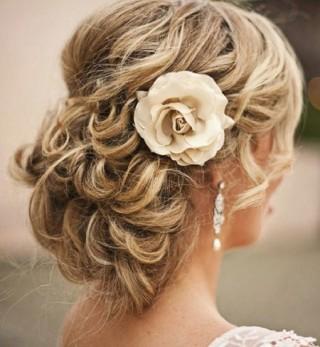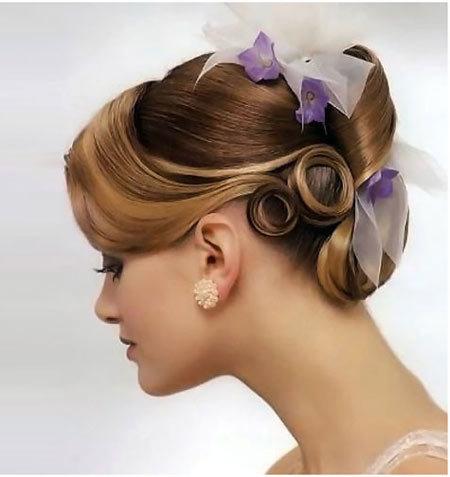Source:- Google.com.pk
A hairstyle, hairdo, or haircut refers to the styling of hair, usually on the human scalp. The fashioning of hair can be considered an aspect of personal grooming, fashion, and cosmetics, although practical, cultural, and popular considerations also influence some hairstyles. The oldest known depiction of hair braiding dates back about 30,000 years. In ancient civilizations, women's hair was often elaborately and carefully dressed in special ways. In Imperial Rome, women wore their hair in complicated styles. From the time of the Roman Empire until the Middle Ages, most women grew their hair as long as it would naturally grow. In the 16th century, women began to wear their hair in extremely ornate styles. In the later half of the 15th century and on into the 16th century a very high hairline on the forehead was considered attractive. During the 15th and 16th centuries, European men wore their hair cropped no longer than shoulder-length. In the early 17th century male hairstyles grew longer, with waves or curls being considered desirable.
The male wig was pioneered by King Louis XIII of France (1601–1643) in 1624. Perukes or periwigs for men were introduced into the English-speaking world with other French styles in 1660. Late 17th-century wigs were very long and wavy, but became shorter in the mid-18th century, by which time they were normally white. Short hair for fashionable men was a product of the Neoclassical movement. In the early 19th century the male beard, and also moustaches and sideburns, made a strong reappearance. From the 16th to the 19th century, European women's hair became more visible while their hair coverings grew smaller. In the middle of the 18th century the pouf style developed. During the First World War, women around the world started to shift to shorter hairstyles that were easier to manage. In the early 1950s women's hair was generally curled and worn in a variety of styles and lengths. In the 1960s, many women began to wear their hair in short modern cuts such as the pixie cut, while in the 1970s, hair tended to be longer and looser. In both the 1960s and 1970s many men and women wore their hair very long and straight.[2] In the 1980s, women pulled back their hair with scrunchies. During the 1980s, punk hairstyles were adopted by some people.Between 27 BC and 102 AD, in Imperial Rome, women wore their hair in complicated styles: a mass of curls on top, or in rows of waves, drawn back into ringlets or braids. Eventually noblewomen's hairstyles grew so complex that they required daily attention from several slaves and a stylist in order to be maintained. The hair was often lightened using wood ash, unslaked lime and sodium bicarbonate, or darkened with copper filings, oak-apples or leeches marinated in wine and vinegar.[9] It was augmented by wigs, hairpieces and pads, and held in place by nets, pins, combs and pomade. Under the Byzantine Empire, noblewomen covered most of their hair with silk caps and pearl nets.[10]
From the time of the Roman Empire until the Middle Ages, most women grew their hair as long as it would naturally grow. It was normally little styled by cutting, as women's hair was tied up on the head and covered on most occasions when outside the home with a snood, kerchief or veil; for an adult woman to wear uncovered and loose hair in the street was often restricted to prostitutes. Braiding and tying the hair was common. In the 16th century, women began to wear their hair in extremely ornate styles, often decorated with pearls, precious stones, ribbons and veils. Women used a technique called "lacing" or "taping," in which cords or ribbons were used to bind the hair around their heads.During this period, most of the hair was braided and hidden under wimples, veils or couvrechefs. In the later half of the 15th century and on into the 16th century a very high hairline on the forehead was considered attractive, and wealthy women frequently plucked out hair at their temples and the napes of their necks, or used depilatory cream to remove it, if it would otherwise be visible at the edges of their hair coverings.Working-class women in this period wore their hair in simple styles.
Wedding Hairstyles For Medium Length Hair Hairstyle for Men 2014 for Women For Girls For Boys For Round Face For Short Hair For Long Hair For Wedding
Wedding Hairstyles For Medium Length Hair Hairstyle for Men 2014 for Women For Girls For Boys For Round Face For Short Hair For Long Hair For Wedding
Wedding Hairstyles For Medium Length Hair Hairstyle for Men 2014 for Women For Girls For Boys For Round Face For Short Hair For Long Hair For Wedding
Wedding Hairstyles For Medium Length Hair Hairstyle for Men 2014 for Women For Girls For Boys For Round Face For Short Hair For Long Hair For Wedding
Wedding Hairstyles For Medium Length Hair Hairstyle for Men 2014 for Women For Girls For Boys For Round Face For Short Hair For Long Hair For Wedding
Wedding Hairstyles For Medium Length Hair Hairstyle for Men 2014 for Women For Girls For Boys For Round Face For Short Hair For Long Hair For Wedding
Wedding Hairstyles For Medium Length Hair Hairstyle for Men 2014 for Women For Girls For Boys For Round Face For Short Hair For Long Hair For Wedding
Wedding Hairstyles For Medium Length Hair Hairstyle for Men 2014 for Women For Girls For Boys For Round Face For Short Hair For Long Hair For Wedding
Wedding Hairstyles For Medium Length Hair Hairstyle for Men 2014 for Women For Girls For Boys For Round Face For Short Hair For Long Hair For Wedding
Wedding Hairstyles For Medium Length Hair Hairstyle for Men 2014 for Women For Girls For Boys For Round Face For Short Hair For Long Hair For Wedding
Wedding Hairstyles For Medium Length Hair Hairstyle for Men 2014 for Women For Girls For Boys For Round Face For Short Hair For Long Hair For Wedding










No comments:
Post a Comment